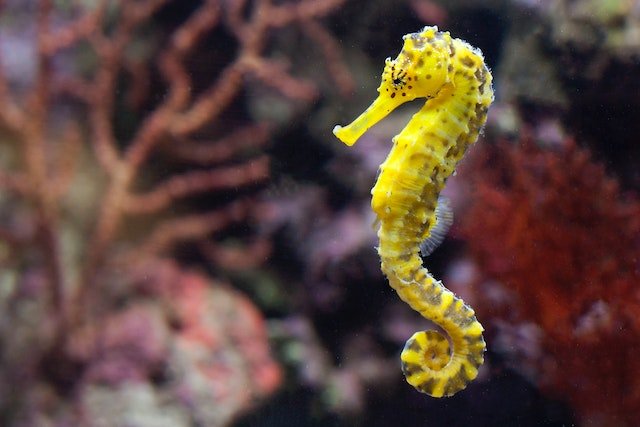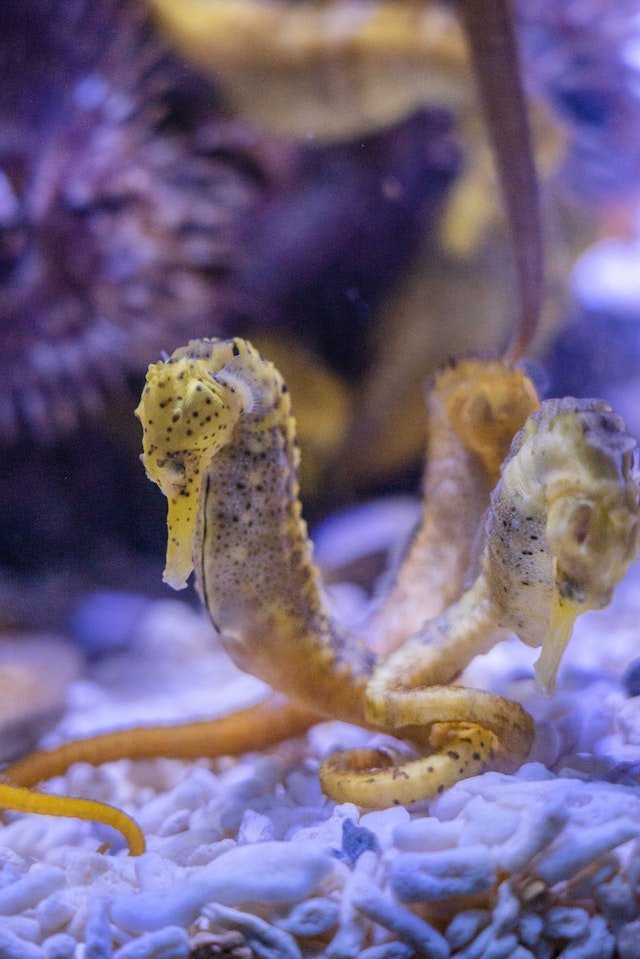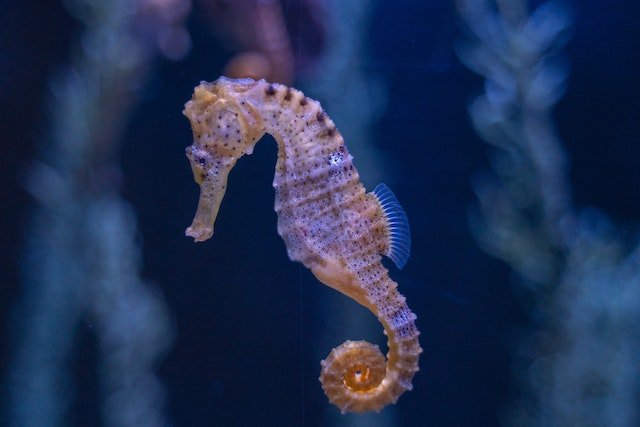A simple answer is yes. As we all know, usually, it’s the female fish that always lay eggs, and the male that fertilizes them either externally or internally. However, some male fish can lay eggs. Let’s take a closer look at this process and why it happens in certain fish species.
Can male fish give birth?
No, male fish cannot give birth, but some species can do something that is almost like giving birth. Certain species of fish, such as live-bearing fishes, can produce offspring without the female ever being involved.
These species are hermaphroditic, meaning they can produce both sperm and eggs.
During spawning, the male will internally fertilize its own eggs, which then hatch out inside the body of the fish. After the young fish have developed, they are expelled from the male fish’s body as fully-formed miniature adults.
Although the offspring are still produced without the involvement of the female, they never pass through her body, as in traditional giving birth.
What male fish can get pregnant?
It’s fascinating to know that the male seahorse is the only species of fish that can get pregnant! They are equipped with a brood pouch on their abdomen that the female seahorse deposits eggs in.
The male seahorse then fertilizes the eggs inside its pouch and carries the fertilized eggs to term. After a month of gestation, the male seahorse gives birth to fully formed baby seahorses. Isn’t it amazing?

What male fish carry eggs?
One type of male fish that carry eggs are sea horses! Male seahorses have a special brood pouch where they carry their mate’s eggs and then give birth to the baby seahorses once they have developed.
All about Seahorses
What is seahorse?
Let’s understand what seahorse is. A seahorse is a small fish belonging to the genus Hippocampus in the family Syngnathidae, which also includes pipefish and seadragons.
These marine animals have a horse-like head and a curved body that tapers into a tail, earning them their name. Seahorses have special fins that help them to swim upright and backward, enabling them to move quickly through the water and evade predators.

Characteristics of Seahorse
Seahorses are an iconic creature with many unique characteristics. They are very small and delicate looking fish, with a slender snout, an armored tail, and an ability to move both backward and forward.
Seahorses have a distinct look, with a ridged crest, elongated snout, and unusual eyes which swivel in different directions. Their bodies are made of overlapping bony plates and they come in many different sizes and colors.
Seahorses have no stomach, meaning they need to eat continuously, so they often feed several times an hour. Additionally, seahorses are well known for being monogamous creatures who mate for life and are devoted parents, carrying their offspring in a pouch until they are ready to hatch.
Seahorses Habitat
Seahorses inhabit many different bodies of water including coral reefs, estuaries, mangroves and even open ocean. They prefer warm, shallow, sheltered and murky areas of the ocean which have plenty of vegetation.
These amazing creatures live in an elaborate symbiotic relationship with their environment, living among seaweed, sea grass and even other animals such as the crab or shrimp.
Seahorses feed mainly on plankton, and for protection, use their body’s ability to blend in with the environment, almost disappearing among the plants and rocks of their habitat. It’s in this environment where they raise their young, engaging in complex mating rituals that often include dancing and courtship displays.
Thanks to the beauty of their unique habits, the seahorse has become a popular creature to learn about, love, and protect.
Seahorses Breeding
Seahorses have one of the most unique mating systems in the animal kingdom, making them incredibly interesting to observe. Unlike most other creatures, seahorses mate for life. Breeding is a complicated and lengthy process that usually begins in the spring, when water temperatures are warmer.
Males begin building an intricate nest that serves as a refuge for both himself and the female. The nest can consist of woven bits of grass, weeds, and other underwater foliage.
The male will guard the nest as the female approaches, a gesture that demonstrates his commitment to her and the eggs they will soon be producing.
Once she has settled into the nest, the pair will entwine their tails, embracing and slowly beginning the courtship dance. This is the stage when the male will begin transferring hundreds of tiny eggs into a brood pouch located in his abdomen.
The female releases the eggs, which then make their way through the water, straight into the pouch of the waiting male.
It takes several weeks for the eggs to be completely transferred, and it is during this period of time that the female will make regular visits to ensure the health of the eggs and the success of the upcoming hatching.
Eventually, when the transfer is complete, the eggs hatch into the water in an astounding synchronised process. As the male seahorse brings up hundreds of new young in the world, both him and the female have already established a loving, committed bond that will last them the remainder of their lives.
Seahorse Eggs
Seahorses may look cute, but don’t be fooled – these tiny sea creatures lay up to 1,500 eggs each. In most cases, seahorses mate in pairs and the male carries the eggs in a special pouch located on the underside of his tail.
During the courtship, the male seahorse grasps the female tightly in a form of embrace to fertilize the eggs that the female has released into his pouch.
The eggs are the size of pinheads and generally are encased in a translucent protective capsule of proteins. Inside this capsule, the eggs appear like orange-yellow balls filled with a tiny yolk sac.
Incubation of these eggs normally takes between 9 and 45 days, depending on water temperature, food availability and other environmental conditions. The egg’s rate of hatching depends largely on how quickly it obtains oxygen from its surroundings.
When it is ready, the hatched baby seahorse, which has grown from 0.3mm to around 2.5cm in length, breaks through its capsule with a unique snout organ and starts life on its own.
Since the males do not provide any form of parental care for their young, these tiny seahorses are fully dependent on their environment for food, shelter, and protection.
Seahorse Diet
Seahorses are interesting creatures that are beloved by many, with their long bodies and adorable face! But what many people don’t know is what their diet looks like.
Seahorses primarily feed on small crustaceans such as brine shrimp, small fish, mysid shrimp, and other marine invertebrates. Their specialized, tubular snouts help them suck up their food with ease, which is why it’s important for them to live in a well-oxygenated habitat with plenty of potential meals around.
They feed several times a day and use their sharp teeth to break up the exoskeletons of their prey, which provides an easier way for them to consume it.
Additionally, seahorses supplement their diet with other tiny animals like plankton. Due to their voracious appetites, some species can consume up to 3000 individual meals in one day!
Seahorse Nest
Seahorses nest during mating season in shallow warm waters, typically near coral reefs and estuaries. When mating, the male will guard the nest of eggs and even protect the eggs from predators, wrapping its tail around them.
It’s quite a fascinating behavior that these little fish will perform to protect its progeny. It takes about 10-25 days for the eggs to hatch depending on the species, with the newborns already looking like miniature adults, complete with its trademark snout.
They usually congregate in huge shoals to provide some level of protection and will quickly disperse into the surrounding waters when predators come by. The whole mating process can take a couple of hours and involve much graceful undulation and colour changes as a courtship ritual.
Seahorse Species
There are over 50 known species of seahorses, and here are some of the most commonly known seahorse breeds:
- White’s seahorse (Hippocampus whitei)
- Hedgehog seahorse (Hippocampus spinosissimus)
- Lined seahorse (Hippocampus erectus)
- West Australian seahorse (Hippocampus subelongatus)
- Yellow seahorse (Hippocampus kuda)
- Dwarf seahorse (Hippocampus zosterae)
- Great seahorse (Hippocampus kelloggi)
- Tiger tail seahorse (Hippocampus comes)
- Big-belly seahorse (Hippocampus abdominalis)
- Pacific seahorse (Hippocampus ingens)
- Thorny seahorse (Hippocampus histrix)
- Japanese pygmy seahorse (Hippocampus bargibanti)
- Coleman’s pygmy seahorse (Hippocampus colemani)
- Pontoh’s pygmy seahorse (Hippocampus pontohi)
- Denise’s pygmy seahorse (Hippocampus denise)
- Bargibant’s pygmy seahorse (Hippocampus bargibanti)
- Satomi’s pygmy seahorse (Hippocampus satomiae)
- McCosker’s flasher wrasse (Paracheilinus mccoskeri)
- Dr Seuss fish (Belonoperca pylei)
- Black bar chromis (Chromis retrofasciata)
- Reunion damselfish (Pomacentrus alexanderae)
- Papuan goby (Redigobius papuanus)
- Gilded triggerfish (Xanthichthys auromarginatus)
- Half and half chromis (Chromis vanbebberae)
- Ornate wrasse (Cirrhilabrus adornatus)
- Zebra snout seahorse (Hippocampus barbouri)
- Diana’s pigmy seahorse (Hippocampus pontohi)
- Brazilian pygmy seahorse (Hippocampus natalensis)
- Coleman’s seahorse (Hippocampus colemani)
- Estuary seahorse (Hippocampus kuda)
- European seahorse (Hippocampus hippocampus)
- Harlequin seahorse (Hippocampus histrix)
- Korean seahorse (Hippocampus haema)
- Midget seahorse (Hippocampus zosterae)
- Painted seahorse (Hippocampus kuda)
- Parrot seahorse (Hippocampus debelius)
- Thorn-tailed seahorse (Hippocampus spinosissimus)
- Yellow-tailed seahorse (Hippocampus trimaculatus)
- Pinto’s seahorse (Hippocampus kuda)
- Short-headed seahorse (Hippocampus breviceps)
- Chinese seahorse (Hippocampus jayakari)
- Long-snout seahorse (Hippocampus guttulatus)
- West African seahorse (Hippocampus algiricus)
- Lined seahorse (Hippocampus erectus)
- Mediterranean seahorse (Hippocampus fuscus)
- Thornback seahorse (Hippocampus spinosiss)
Seahorses are fascinating creatures with a unique appearance and over 50 known species found in oceans around the world.
Do all fish lay eggs?
The answer is No, not all fish lay eggs. While most fish lay eggs, some species like eels, sharks, and rays use alternative reproductive methods like live-bearing, in which their young are hatched and born alive rather than hatching from eggs.
Read more: Do fish eat their own eggs?
Do any male animals produce eggs?
Generally speaking, eggs are only produced by female animals. However, certain species, like sea horses and hammerhead sharks, buck the trend and males are the ones who are able to produce eggs.
Do male clown fish carry eggs?
No, male clown fish do not carry eggs. Female clown fish lay the eggs and the males take on the responsibility of guarding the eggs until they hatch. The male clown fish will fiercely defend their eggs from predators and fan the eggs with their fins to keep them well-oxygenated.
Do male bettas carry eggs?
No, male bettas do not carry eggs. Male bettas do not have egg-carrying capabilities since they lack the female reproductive organ needed to do so. Instead, female bettas are responsible for laying eggs and fertilizing them after mating with a male betta.
The female betta will lay hundreds of eggs and is the only fish species to do so outside of their mouth.
Do male cichlids carry eggs?
No, male cichlids do not carry eggs. However, during mating, the female cichlid lays the eggs in the substrate which the male will then fertilize. Afterwards, the male cichlid guards the eggs and defends them against other cichlids in the aquarium.
He also fans them with his fins in order to increase oxygen supply and clear away debris from around the eggs.
Do male goldfish lay eggs?
No, male goldfish do not lay eggs. Unlike some other fish, goldfish do not practice sexual reproduction, meaning males cannot lay eggs. Rather, male and female goldfish are externally similar and reproduce by releasing sperm and eggs into the water.
The eggs then stick to plants and surfaces in the aquarium. The eggs are fertilized by the male’s sperm and hatch into young fry.
Final Words
After careful research, we can conclude that not all male fish lay eggs or give birth. Certain species such as seahorse give birth. All in all, male fish usually do not lay eggs or give birth, but some exceptions do exist.
Recent Posts
What Does Kiviak and Its Eggs Really Taste Like and How Do You Even Eat It?
Kiviak and its eggs taste like fermented blue cheese mixed with oily game meat, wrapped in a punch of ammonia. This dish, found in Greenland, is made by stuffing hundreds of whole auk birds into a...
Are Ethical Concerns in Egg and Chicken Farming Being Ignored?
Egg and chicken farming has raised significant ethical concerns, affecting both the animals involved and the consumers who rely on these products. The conditions in which chickens are raised, their...

